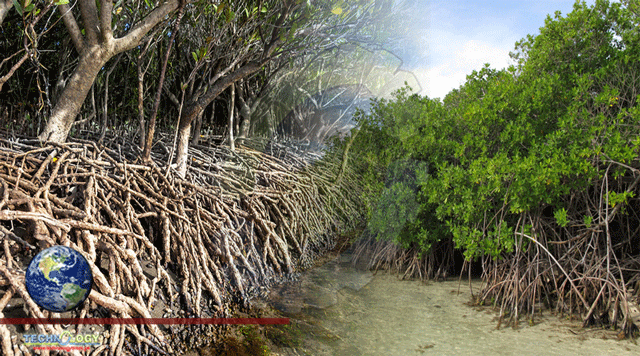Nearly 200 kilometers from the sea, red mangroves thrive in the rainforests along the San Pedro Mártir River on the Yucatán Peninsula. But how did these tangled trees that typically grow in salty water along coasts end up trapped so far inland and in freshwater?

Carlos Burelo has been mulling a version of that question ever since he visited the river on a fishing trip with his father 35 years ago. As a kid, he saw how the mangroves with their twisted aboveground roots were different from other trees, an observation that stuck with him into adulthood as a biologist at the Universidad Juárez Autónoma de Tabasco in Villahermosa, Mexico.
Now, genetic analyses, surveys of vegetation and sediments and simulations of shifts in sea levels show that the red mangroves (Rhizophora mangle) are part of a “relict ecosystem” that has existed for more than 100,000 years. When warming during the last interglacial period, which peaked about 130,000 years ago, raised sea levels approximately 9 meters above present-day levels, the lowlands of what’s now the Yucatán Peninsula flooded. As a result, the mangrove forest was displaced and started to grow inland by today’s standards, Burelo and colleagues report in the Oct. 12 Proceedings of the National Academy of Sciences. When sea levels dropped as the world cooled again, the trees were left far from the coast.
To estimate where the mangroves may have been displaced from, the team collected leaves from the trees and from other mangrove forests along the coasts of the Caribbean Sea and Gulf of Mexico and compared the plants’ DNA. That work pinpointed the origins of the inland mangroves about 170 kilometers away along the Gulf of Mexico.
By comparing the number of DNA mutations in the inland population with the other mangroves and by estimating the ages of the trees using tree cores, “we were able to infer [that the San Pedro mangroves] have been isolated for 120,000 years,” says Felipe Zapata, an evolutionary biologist at UCLA. The calcium-rich water and riverbed of the San Pedro has buttressed the survival of these red mangroves over the years, Zapata says.
In addition to the mangroves, the team found various plant species in the inland area that also have a coastal heritage. More than 30 percent, or 112 species, of the total flora growing along the river, including orchids and legumes, are typically found in coastal lagoons or along shorelines, the researchers say.
With those findings in hand, the researchers decided to look at the soil too. The team expected to find “coastal sediments, ocean sediments and perhaps ocean fossils,” says Exequiel Ezcurra, an ecologist at the University of California, Riverside. A geologic survey of sediments near the mangroves revealed “exactly what we expected,” he says, including coastal gravels, shells of marine gastropods, clay sediments rich in shell fragments, coastal dunes and large oyster shells.
Those finds, along with simulations of past sea levels, confirm that at some point during the last interglacial period, the ocean must have merged with the lower basin of the San Pedro River, pushing the red mangroves and other coastal species inland, the researchers conclude.
Discovering this relict ecosystem highlights the widespread impact past changes in the climate have had on the world’s coastlines, Ezcurra says, and it provides a chance to better understand how future sea level rise may affect these ecosystems.
Originally published by Science News